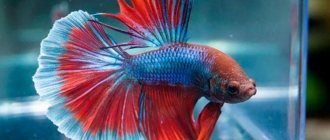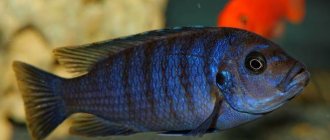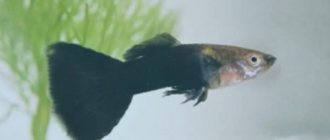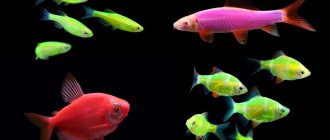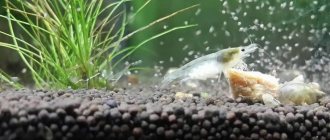To people who are far from aquarium hobby, it may seem that fish are strikingly different from other pets - they are unemotional, do not wag their tail and do not show great joy when their owner appears. However, fish owners become very attached to their charges, and many representatives of the aquarium world reciprocate their feelings. Naturally, an aquarist is interested in the question of how long fish live in captivity. You always want your favorites, even though they are so unusual, to be around for as long as possible. And, of course, it is important to know how to extend this period.
Life expectancy of the most common fish breeds
Despite the fact that everything is individual, there are average indicators of how long certain fish live:
- in baloo sharks, common loaches, and piranhas, the lifespan usually does not exceed 10 years;
- metinnis, nimbochromis, Malawian cichlids, angelfish, cockroaches, sturizoms, panacia - more than 10 years;
- in apistograms, guppies, swordtails, platies, iris, gourami - the life span does not exceed 5 years, most often the cycle is only 3-4 years;
- cardinals, neons and mollies usually live no more than 4 years;
- tetradons, squirters, wedge-bellies, synodontis, congos, otocinclus, mystus - a 5-year life span is measured;
- tetras and lalius live about 5-6 years;
- life expectancy of zebrafish and corydoras catfish is 5-7 years;
- in labeos, barbs, black morulis, and rastobors, this period varies from 4 to 10 years;
- Angelfish and glass catfish live on average about 8 years;
- the life cycle of plecostomus, banjo catfish, and frontoz is 7–15 years;
- cichlazomas and botia live from 10 to 15 years;
- astronotus, discus and severum - from 10 to 18 years;
- Long-livers are often found among goldfish - they live from 10 to 30 years.
Water condition
How long pet fish live in an aquarium is also determined by the quality of the water. If the water is too polluted or not saturated with oxygen in the required amount, you should not expect that the inhabitants of the aquarium will live long lives. For some of them, a temperature difference of 1 - 2 degrees is of great importance. This means it has a strong impact on the condition of pets, which also shortens their lifespan. There are temperature limits, if violated, the death of certain species of fish is possible. Therefore, this factor is no less important than the composition of the diet and water quality.
Aquarium inhabitants are divided into warm-blooded (cannot tolerate temperatures below +18°C - +20°C) and cold-blooded (able to live at +14°C - +25°C). In addition, there are heat-loving fish (high-swimming mollies, cichlids) that require large amounts of oxygen. An aquarium for such species must be spacious (40 liters per individual) and have powerful aeration.
The necessary living conditions for a certain type of fish should be found out before purchasing them. And not when they already started to get sick.
Water quality is a very important factor affecting the lifespan of aquarium fish. Residues of food or rotting parts of plants gradually fill the reservoir with toxins, making the life of underwater inhabitants uncomfortable. Being in such conditions, pets begin to get sick and become depressed. Digestive problems and respiratory dysfunction are possible. All this affects the lifespan of aquarium animals. Therefore, your home pond should be equipped with a good filter and compressor. A third of the total volume of water is replaced with fresh water once a week. Before this, the water must settle to minimize the presence of chlorine.
Life cycle of marine fish
Marine inhabitants are not as common among aquarists as freshwater ones, but many aquarium enthusiasts gravitate towards exotic species and acquire unusual fish without fear of difficulties. The lifespan of such individuals will be longer if they live in water with a balanced level of salt.
It is important to provide them with quality care - often fish die in the first year of life from diseases that arise due to poor living conditions. The following marine species have short lives:
- butterfly fish;
- tangerines;
- Moorish idols;
- bulls;
- triggerfish;
- damselfish fish;
- Napoleons;
- surgeon fish.
They live from 2 to 4 years. Small seahorses from the tropics are also short-lived, their life cycle is only 3-4 years. The lifespan of lionfish, clownfish, eels and groupers in aquarium conditions is 8-10 years. But for marine angelfish, this period takes about 20 years or more.
Famous old-timers
Among the long-livers are sea bass . Their habitat, depending on the species, varies from the intertidal zone to almost 3000 meters in depth. Some species live more than 100 years. The maximum known age was 205 years for the Aleutian sea bass. He was caught off the coast of Alaska.
It's hard to imagine, but he was born long before Alaska became a US state. For all these years, the fish swam quietly, oblivious to the national and personal dramas that were playing out nearby. In fact, this is an unusually old specimen. Most sea bass do not live to be 200 years old, but this fish had a certain genetic reserve, did not get sick and, most importantly, was not caught and eaten.
Ole, as he was called (from ål, Swedish for "eel"), lived in the well of a private house in the town of Brantevik in southern Sweden for almost 155 years. According to the owner of the unusual pet, a Swedish boy threw him there back in 1859. This was a common practice for filtering water. Hungry eels were released into wells and fed on flies and other insects. Ole died in 2014, and his frozen remains are now being held at a freshwater fish research center in Sweden to analyze otoliths to ascertain the creature's true age.
Much of the eel's life cycle is shrouded in mystery. In the wild they die after spawning. Typically, males are expected to live up to 15 years, females up to 20 years. Since Ole never left his cool well with enough food to reproduce, it is theoretically possible that his life span was so long.
The most famous koi (Japanese carp) named Hanako has had several owners in its life. A 1977 growth ring study estimated he was 225 years old.
Thanks to advanced techniques used to obtain information about the age and growth of fish, it is now known that many species may be at least twice as old as previously thought. In the early 1980s, the Atlantic roughy fishery reached alarming proportions. was thought to live for about 30 years . But by the late 1990s it became apparent that it had a very low level of productivity and had a life expectancy of up to 100 years.
Of course, more efforts are needed to test the methods used and find new analyzes of age data as fish populations continue to decline due to overexploitation.
What is the lifespan of fish associated with?
The owner, when choosing a population for his aquarium, can focus on various criteria, including taking into account their life expectancy. Perhaps a person’s plans do not include long-term maintenance of a tank, or perhaps this is his favorite thing, and he cannot imagine life without underwater inhabitants.
It is important for professional breeders to consistently produce offspring, therefore, the more spawnings they carry out, the better. The duration of the life cycle of fish is associated with the following factors:
- size of individuals;
- temperature conditions;
- nutritional disorders - overfeeding or underfeeding;
- livability and neighborliness;
- tank volume.
In some cases, just because of one violation, the fish cycle can be significantly shortened.
Piranha pacu - decoration of an artificial pond
Unlike the predatory members of the family, omnivorous piranhas of the pacu genus prefer a vegetarian diet, but can feast on small unwary fish.
Brown pacu - a vegetarian piranha with a “fine mental organization”
In captivity, the herbivorous piranha grows up to 60 cm, which means that a flock of 4–5 specimens will require an aquarium with a volume of 1000–1500 liters. A pack is a prerequisite for the normal existence of a paku; together they feel much more confident.
In general, these relatives of evil, gluttonous and fearless predators are very timid. Paku panics when the light suddenly turns on, accidental hits on the glass, or even just sudden movements near the aquarium. Therefore, the ideal option for keeping them is an artificial pond, in which the school will behave calmer, and the fish can live up to 12-15 years.
Fish size
This is one of the main criteria. As you know, in the body of small individuals all vital processes occur faster, which is why they live less than their larger relatives. The shortest life is found in fish whose size does not exceed 5 cm, for example, “swords”, “gupeshki”, neons do not often live to see their 5th anniversary and often die after 1-2 years.
The cinolebias fish found in the waters of South America turned out to be unusually small. The length of their life cycle is directly related to the rainy season. As soon as it stopped and dry days arrived, the resulting reservoirs dried up and the cinolebias died. But this species did not die out - during its entire 6-month life, the fish managed to spawn eggs. It took them six months to be born, reach puberty, leave offspring, and die.
Medium-sized fish live about 10-15 years, but among them there are also long-livers; for example, the lifespan of piranhas can reach a quarter of a century. Naturally, such inhabitants will stay around longer, and this is important to take into account when introducing them. Interestingly, females live less than males, and often the difference reaches 1.5-2.5 years. In some species, females die immediately as soon as they give birth to offspring.
Of course, not a single aquarium fish is immune from diseases and unsuccessful births, but most often this occurs in viviparous guppies and swordtails.
How many years do fish live in nature, influencing factors, table
The age of the fish is of little concern to the angler. For us, size and weight come first. We are proud of such trophy performance. But it may also turn out that the caught fish was born much earlier than the fisherman himself. Is it possible. Even scientists are unlikely to give an exact answer for how long fish live in their natural conditions. Too many factors influence the lifespan of fish in nature. These are genetics, metabolism, age of reproductive maturity and its end, external environmental factors. Yes, and we, spinners and floaters, are included in the list of unfavorable conditions.
Anyone who is passionate about fishing is probably familiar with historical data about the oldest pike in the world. In 1230, she was marked with a dated ring by Frederick the Second and released into the water. After 267 years, in 1497, fishermen caught it again. 6 meters long and 158 kg weight. That's what the description says.
Whether to believe such information or not, everyone decides for themselves. She seems "phony" to me. Like that photo where three fishermen are holding one pike.
However, Neptune is with them, such “bearded” data. Let's go back to modern times. So how long can a fish live in the wild? How can ichthyologists answer this question? Again, understanding that we are not talking about ideal living conditions. It will not be possible to conduct laboratory research for an unlimited number of years. Laboratory assistants come and go, there is no money, maintaining a constant environment, etc. All that remains is to use the data obtained during catches for the benefit of science. And, naturally, from research on trophies received from fishermen. Let's take a look at the table.
How long do fish live according to scientific research?
The data was obtained from determinations ranging from counting the number of annual rings on the scales to spectral analyses.
| Types of fish | Maximum number of years to live |
| Acne | 55 |
| Grayling | 20 |
| Brown trout | 20 |
| Barbel | 20 |
| Perch | 25 |
| Bream | 20 |
| Chub | 22 |
| Gudgeon | 8 |
| Pike | 65 |
| crucian carp | 25 |
| Carp | 30 |
| Salmon | 10 |
| sea trout | 15 |
| Asp | 20 |
| Rainbow trout | 10 |
| Roach (roach) | 12 |
| Burbot | 15 |
| Tench | 25 |
| Smelt | 4 |
The data is a little shocking when you consider that if the fish had not been caught, how many more years would it have lived? Just like the situation when a 12-year-old boy catches a perch a quarter of a century old.
And this is not the maximum lifespan of a fish. Sure. In nature, fish do not often live to an old age and die from old age. Most die from disease and become prey to larger relatives and predators. Birds, animals, fishermen. Any fluctuation in the characteristics of the habitat causes stress, which necessarily shortens life expectancy. pH, water hardness, temperature, oxygen content and waste products. Just look at our human life. And those fish that were lucky enough to die in old age fell to the bottom of the reservoir and turned into food for bacteria.
So no one knows how many years fish live, one can only guess. But their life is definitely not easy. I looked at the worm and became dinner myself.
Temperature indicators
The water temperature has a significant influence on the duration of the life cycle of the inhabitants of the aquarium. The peculiarity of cold-blooded creatures is that they are not able to independently regulate their body temperature, so water performs this function. The temperature of the water in the tank is the same for its inhabitants.
The warmer the aquatic environment, the more active the metabolism in the fish’s body. This leads to faster wear and a shorter life cycle. In some cases, the life of fish becomes shorter by more than one year.
How to determine the age of aquarium fish
You can understand that there are young specimens of a certain species of fish in a pet store aquarium based on several signs. They should be active and energetic, have shiny scales and clear eyes without any cloudy veil.
A sick fish or one that is at a “venerable” age becomes inactive. The individual prefers to spend more time at the bottom, occasionally floating to the surface. Moreover, some species can remain active almost until their last days. Therefore, it is possible to distinguish an elderly pet only before its death. In thorns, for example, this is expressed in a loss of brightness of color: it becomes faded. The barb loses individual scales, and the fins of the macropod become saggy.
Juveniles are usually not as brightly colored as adults of the same species. Using the example of the swordtail, you can see that it acquires a rich body color only by 6 months.
If we talk about young ancistrus catfish, they do not have antennae, characteristic of adults whose age exceeds 1 year. This is the main difference between the young of this type of fish.
The size of young fish is smaller than that of adult fish. But sometimes this can be a consequence of poor care or nutrition, and indicate their improper development. Therefore, you need to find out in what conditions a particular fish lived before it was put up for sale.
Diet and feeding regime
Another important aspect that affects the life of aquarium inhabitants. As a rule, fish can suffer from both overfeeding and lack of food:
- Overfeeding . Obesity is a common pathology that occurs due to owner mistakes. Often, fish eat more than they should when the family does not have a clear schedule - they feed everyone who remembers about them, give food “by eye”, without worrying about the portion size, or allow them to give food to children in order to please the latter with a funny spectacle.
- Underfeeding . If fish are malnourished, they become deficient in nutrients, vitamins and microelements. They become lethargic and inactive, as they lack strength.
If the owner doubts whether his charges are getting enough food, you can sniff the water - if too much food gets into it, it acquires a specific smell. It is best if it does not emit any foreign aroma. You should worry about overfeeding your fish in the following cases:
- if the water in the tank smells rotten;
- quickly loses transparency and becomes cloudy;
- a film appears on the surface;
- plants and decor become covered with an unpleasant, slimy layer.
The main rule of feeding any pets, including aquatic ones, is moderation. According to generally accepted rules, fish should receive as much food as they can consume within a few minutes of starting their meal.
How to extend life
Simple rules will help extend the life of aquarium fish. You will need to maintain the normal state of the water and monitor its temperature.
Food that is not eaten within 5 to 7 minutes must be removed from the reservoir so that it does not cause contamination. If this happens, the water is partially replaced with fresh water, without waiting until it becomes completely cloudy.
If a sick fish is discovered, it is removed from the common container as quickly as possible to prevent an epidemic.
A properly built ecosystem significantly affects water quality. To do this, plants are planted in the ground and snails are introduced, which are the “orderlies” of the aquarium. Such measures help extend the life of pets and simplify the care of the aquarium.
Smart neighborhood
Often, in pursuit of the aesthetic beauty of the aquarium, novice owners miss this point. In such situations, a common tank turns out to be a not entirely comfortable place for all inhabitants:
- Large predators begin to eat smaller neighbors - what are the chances of the latter living all the time allotted to them by nature?
- Territorial fish clearly monitor their zone - they firmly drive away everyone who invades it. And then what should the rest of the inhabitants do, who prefer to live in the same layer of the aquatic environment? Just feel stressed and hide.
- Phlegmatic fish with luxurious fins constantly suffer from hooligan, hyperactive neighbors - they will definitely bite and rip off tails and fins, while the victims not only experience stress, but also often get sick and do not live long.
- Many representatives of the breeds cannot stand their own brothers. For example, just a couple of cockerels can turn an aquarium into a constant battlefield, and these fighting fish fight not only until first blood is drawn.
These are not all unfortunate combinations of creatures forced to live in the same territory due to the “light hand” of the owner.
The black-lined royal panak is a striped native of South America
These catfish from the Locaria family attract attention with their spectacular coloring, original shape of fins, and non-standard proportions of the head and body. Heat-loving fish with pronounced territorial behavior will not feel well in cool water and will not get along with catfish of other species, but they will become good neighbors for cichlid predators living on the “upper floors”. The latter will not harm the panak, whose body is reliably protected by bone plates.
Black-lined panakas grow up to 30 cm in length, and therefore the volume of water for a comfortable stay for one individual must be at least 200 liters. When designing an aquarium, it is necessary to provide for the possibility of arranging a shelter for the catfish, which should be spacious enough, otherwise the panak may get stuck in it.
Like all locarid catfish, king panakas require a source of cellulose. By placing a driftwood in the aquarium, you will solve this issue - the catfish will chew it with pleasure. Diversify his diet with vegetables and spirulina tablets.
Black-striped Royal Panak - lover of snags and shelters
Striped bighead catfish live up to 10 years if the environmental conditions are comfortable and the diet is balanced and correct.
As a rule, even professionals do not breed black-striped panakas in captivity; they are supplied to aquarium farms from their natural habitats.
Cichlozomas severum - royal “feudal lords” with the ability to fictitiously change sex
Cichlozomas severum live in pairs; several pairs can only be kept in a very large aquarium, divided into separate zones. The fish actively defend their territory from other severums.
Cichlosoma severum is distinguished by its regal appearance and graceful movements.
In the absence of males, females can form false “family” pairs, in which one of the fish, without changing gender, takes on the male’s “responsibilities” in protecting the territory.
Cichlozomas severum are omnivorous, unpretentious to light, elegant and regally beautiful. In good conditions they live up to 15-18 years. Creation date: 02/17/2020
